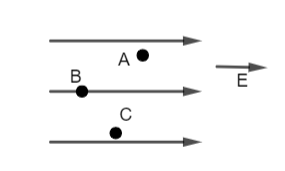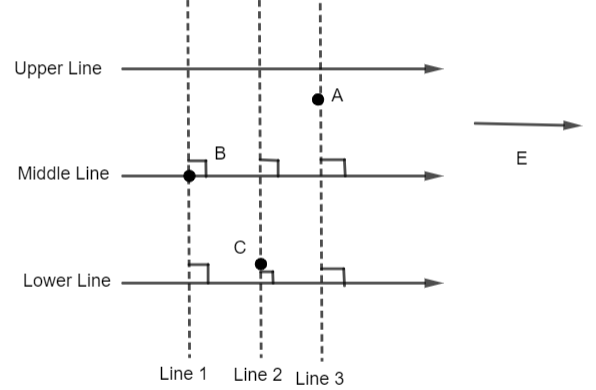
A, B and C are three points in a uniform electric field. The electric potential is:

(a) Maximum at A
(b) Maximum at B
(c) Maximum at C
(d) Same at all the three points A, B and C

Answer
434.1k+ views
Hint: The electric field € and the potential changes with the distance of the point from the charge. The electric field at a point in the field is equal to the negative of the potential gradient. So use the concept of equipotential surface and calculate the momentum potential from points A, B and C placed in the electric field.
Complete step by step answer:

We know that the electric field intensity and the electric potential vary with the distance of the point from the charge. The relation between the electric field intensity and the potential is given as
This is the work done per unit charge displaced is nothing but the increase in potential dV, i.e. dV is the small change in potential over the distance dx.
The quantity from equation (i),
So, according to the above concept, the potential at B must be greater but it has one condition which is described as below.
We know that the line perpendicular to the direction of
Therefore, the potential at point B is more than C and B. So, the potential at points are
Therefore, option (b) is the right answer.
Additional Information: The electric field intensity at any point in the electric field is equal to the negative rate of change of potential with respect to the distance at that particular point which is measured in the direction of electric intensity.
S.I unit of the potential gradient is volt/meter (V/m).
Since dV is the potential and work done per unit charge displaced is the increase in the potential and it is found that the work done does not depend upon the path chosen for moving the test charge from one point to the other.
Note:
The term is given in the equation (i),
Complete step by step answer:

We know that the electric field intensity and the electric potential vary with the distance of the point from the charge. The relation between the electric field intensity and the potential is given as
This is the work done per unit charge displaced is nothing but the increase in potential dV, i.e. dV is the small change in potential over the distance dx.
The quantity from equation (i),
So, according to the above concept, the potential at B must be greater but it has one condition which is described as below.
We know that the line perpendicular to the direction of
Therefore, the potential at point B is more than C and B. So, the potential at points are
Therefore, option (b) is the right answer.
Additional Information: The electric field intensity at any point in the electric field is equal to the negative rate of change of potential with respect to the distance at that particular point which is measured in the direction of electric intensity.
S.I unit of the potential gradient is volt/meter (V/m).
Since dV is the potential and work done per unit charge displaced is the increase in the potential and it is found that the work done does not depend upon the path chosen for moving the test charge from one point to the other.
Note:
The term is given in the equation (i),
Recently Updated Pages
Basicity of sulphurous acid and sulphuric acid are

Master Class 12 Economics: Engaging Questions & Answers for Success

Master Class 12 Maths: Engaging Questions & Answers for Success

Master Class 12 Biology: Engaging Questions & Answers for Success

Master Class 12 Physics: Engaging Questions & Answers for Success

Master Class 4 Maths: Engaging Questions & Answers for Success

Trending doubts
Give 10 examples of unisexual and bisexual flowers

Draw a labelled sketch of the human eye class 12 physics CBSE

a Tabulate the differences in the characteristics of class 12 chemistry CBSE

Differentiate between homogeneous and heterogeneous class 12 chemistry CBSE

Why is the cell called the structural and functional class 12 biology CBSE

Differentiate between insitu conservation and exsitu class 12 biology CBSE




